
Dillwynia tenuifolia is a species of flowering plant in the family Fabaceae and is endemic to eastern New South Wales. It is an erect shrub with linear leaves, and orange-yellow and red flowers.

Dillwynia cinerascens, commonly known as grey parrot-pea, is a species of flowering plant in the family Fabaceae and is endemic to south-eastern Australia. It is an erect to low-lying shrub with linear or thread-like leaves and orange or yellow flowers.
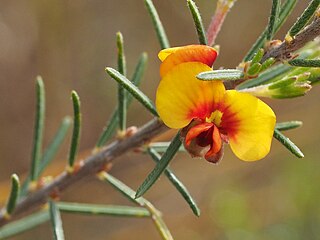
Dillwynia sericea, commonly known as showy parrot-pea, is a species of flowering plant in the family Fabaceae and is endemic to south-eastern Australia. It is an erect to low-lying shrub with hairy stems, linear leaves and apricot-coloured flowers, usually with a red centre.

Pultenaea juniperina, commonly known as prickly bush-pea or prickly beauty is a species of flowering plant in the family Fabaceae and is endemic to south-eastern Australia. It is an erect, spiky shrub with hairy stems, linear to narrow elliptic leaves with stipules at the base, and yellow-orange and red flowers.

Persoonia juniperina, commonly known as prickly geebung, is a species of flowering plant in the family Proteaceae and is endemic to south-eastern Australia. It is a small erect to low-lying shrub with smooth bark, hairy new branches, linear leaves, yellow flowers borne singly or in groups of up to forty in leaf axils, and yellowish green to purplish fruit.

Dillwynia floribunda is a species of flowering plant in the family Fabaceae and is endemic to eastern Australia. It is an erect shrub with hairy stems, crowded, grooved, linear leaves and yellow flowers with red markings.
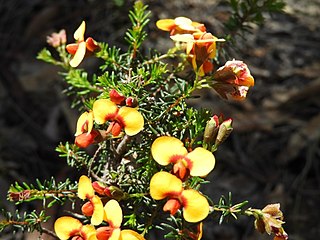
Dillwynia phylicoides, commonly known as small-leaf parrot-pea, is a species of flowering plant in the family Fabaceae and is endemic to eastern Australia. It is an erect to open shrub with twisted, linear to narrow oblong leaves, and yellow and red flowers.

Dillwynia acicularis is a species of flowering plant in the family Fabaceae and is endemic to New South Wales. It is an erect shrub with linear, grooved leaves and yellow flowers with red markings.
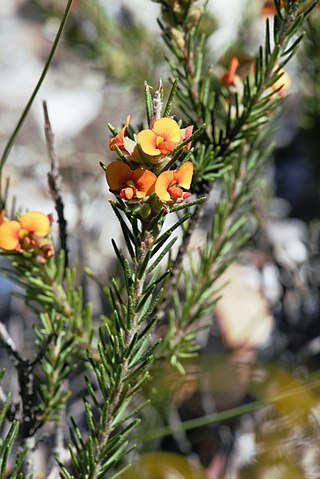
Dillwynia brunioides, commonly known as sandstone parrot-pea, is a species of flowering plant in the family Fabaceae and is endemic to New South Wales. It is an erect shrub with silky-hairy stems, linear, grooved leaves and yellow flowers with red markings.

Dillwynia hispida , commonly known as red parrot-pea, is a species of flowering plant in the family Fabaceae and is endemic to south-eastern Australia. It is an erect shrub with more or less glabrous stems, linear to thread-like leaves and orange and red, partly crimson flowers.

Dillwynia prostrata, commonly known as matted parrot-pea, is a species of flowering plant in the family Fabaceae and is endemic to south-eastern continental Australia. It is a prostrate shrub with hairy stems, linear to narrow oblong or spatula-shaped leaves and yellow and dark red flowers.
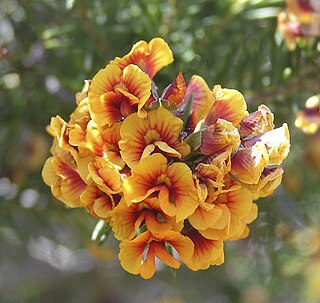
Dillwynia pungens is a species of flowering plant in the family Fabaceae and is endemic to the south coast of Western Australia. It is an erect, spindly shrub with cylindrical leaves and yellow flowers with red or orange markings.

Dillwynia ramosissima, commonly known as bushy parrot-pea, is a species of flowering plant in the family Fabaceae and is endemic to south-eastern continental Australia. It is a low-lying to erect shrub with linear to narrow oblong or spatula-shaped leaves and yellow flowers with red markings.
Dillwynia rupestris is a species of flowering plant in the family Fabaceae and is endemic to the Gibraltar Range National Park in New South Wales. It is an erect, single-stemmed shrub with linear leaves and yellow flowers with red markings.

Dillwynia sieberi, commonly known as Sieber's parrot-pea, is a species of flowering plant in the family Fabaceae and is endemic to eastern Australia. It is an erect shrub with rigid, needle-shaped, sharply-pointed leaves and yellow to yellow-orange flowers with reddish-brown markings.
Dillwynia stipulifera is a species of flowering plant in the family Fabaceae and is endemic to New South Wales. It is an erect to spreading shrub with hairy stems, linear leaves and yellow flowers with red markings.

Dillwynia uncinata, commonly known as silky parrot-pea, is a species of flowering plant in the family Fabaceae and is endemic to southern Australia. It is an erect, spreading shrub with cylindrical leaves and yellow flowers with a red centre.
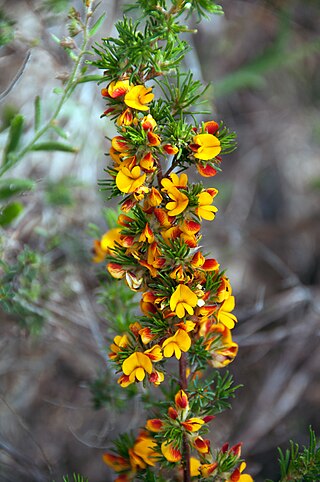
Pultenaea acerosa, commonly known as bristly bush-pea, is a species of flowering plant in the family Fabaceae and is endemic to south-eastern continental Australia. It is a rigid, much-branched shrub with glabrous, grooved, needle-shaped leaves and yellow flowers with red veins.
Pultenaea benthamii, commonly known as Bentham's bush-pea, is a species of flowering plant in the family Fabaceae and is endemic to south-eastern continental Australia. It is an erect shrub with sharply-pointed, narrow elliptic to linear leaves and yellow to orange and red flowers in clusters at the ends of branches.

Epacris purpurascens is a species of flowering plant in the heath family Ericaceae and is endemic to eastern New South Wales. It is an erect shrub with egg-shaped or heart-shaped, sharply-pointed leaves and white or pink, tube-shaped flowers.
















